Terumot and Ma’aserot 101: a Halachic Guide

The 40 basic concepts below relate to all aspects of terumot and ma’aserot. This guide describes the various gifts, when they are given, and more.
|
Basic concepts |
Additional concepts |
Concepts related to the formula for setting aside terumot and ma’aserot |
1. Terumah (offering)
A gift given to the Kohen, as per Torah obligation, including terumah gedolah and terumat ma’aser.
2. Ma’aser (tithe)
A tenth separated from produce. There are several gifts that this term applies to: ma’aser rishon, terumat ma’aser, ma’aser sheni, and ma’aser ani. After setting aside the terumah gedolah (great offering) for the Kohen, an additional tenth is set aside and designated as ma’aser rishon (first tithe). A tenth of the ma’aser rishon is also given to the Kohen (known as ma’aser min hama’aser [a tithe of a tithe] and terumat ma’aser [tithe offering]). Then, yet another tenth is separated from the remainder. During certain years this tenth is designated as ma’aser sheni (second tithe), on other years as ma’aser ani (poor man’s tithe).
3. Terumot and ma’aserot (offerings and tithes)
Mitzvot that obligate produce owners to set aside a portion of their produce for a Kohen and another portion for a Levite. Yet another portion goes to a poor person or is brought to Jerusalem to be eaten in purity in Temple times (depending on the year in the shemitah cycle). The names of these gifts are: terumah gedolah, ma’aser rishon, terumat ma’aser, ma’aser ani, and ma’aser sheni.

4. Terumah gedolah (great offering)
A gift given to the Kohen by the owner of produce set aside from produce grown in years 1 to 6 of the shemitah cycle. Even a very small quantity is sufficient according to the Torah, but the Sages instituted that one must set aside approximately two percent of the produce. The terumah gedolah can be consumed in all places but only by Kohanim and their families when they are in a state of ritual purity. Since today Kohanim are unable to eat terumah due to ritual impurity, the Sages instituted setting aside the portion ordained by the Torah, that is, a small amount. This gift is imbued with sanctity, and it is forbidden to degrade or destroy it. Today, Kohanim cannot eat terumah since they are ritually impure. However, it is possible to either feed the terumah gedolah to their animals (livestock, pets). Alternatively, one can bury it or to double bag the food and dispose of it in the garbage can.
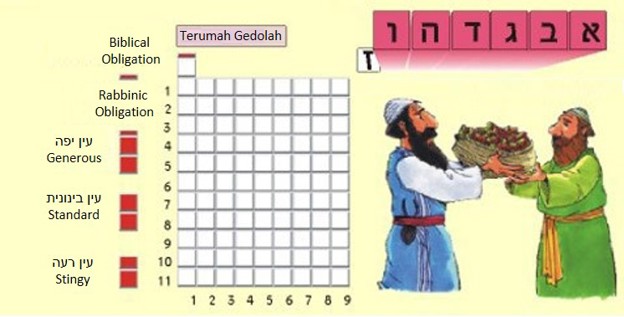
Produce owner giving terumah gedolah to a Kohen
5. Ma’aser rishon (first tithe)
The owner of the produce gives this gift to the Levite from crops grown in years 1 to 6 of the shemitah cycle. The quantity set aside is 10% of the produce left after separating the terumah gedolah. Although the ma’aser rishon is for the Levites, with their permission Israelites are allowed to partake of it as well. This gift is not sacred and can be eaten in all places even in a state of ritual impurity. The ma’aser rishon should be given to a Levite, even today, when there is a clear obligation to set aside ma’aser rishon (tevel vaday), such as when the produce was grown in one’s garden. It is possible to give this gift through the Beit Ha'otzar fund of the Torah VeHa’aretz Institute. If the obligation to set aside ma’aserot is uncertain (safek tevel), such as when produce is bought in an open market where it is possible that the produce was previously tithed, one must still set aside ma’aser rishon. Afterwards, though, it is permissible to keep and eat the produce.
 The produce owner giving ma'aser rishon to a Levite
The produce owner giving ma'aser rishon to a Levite
6. Terumat ma’aser (tithe offering)
A gift the Levite gives the Kohen from the ma’aser rishon. It is separated from produce grown from years 1 to 6 of the shemitah cycle. A tenth of the ma’aser rishon is set aside, which is essentially 1/100 (me’it) of the produce (after the separation of the terumah gedolah). Terumat ma’aser is permissible for consumption in all places, but only to Kohanim and their families when they are in a state of ritual purity. This gift is imbued with sanctity and it is forbidden to degrade or destroy it. Today, generally the owner of the fruit is the one who sets aside terumat ma’aser. Some bury it in the ground while others double bag it and dispose of it in the garbage. It is also possible to feed it to a Kohen’s pets or livestock.

7. Ma’aser sheni (second tithe)
This gift is for the owner of the produce. This gift is set aside from the produce grown during years 1, 2, 4, and 5 of the shemitah cycle. The quantity to be separated is 1/10 from the 90/100 left after the separation of ma’aser rishon, that is, 9/100 (9%). The owner of the fruits and vegetables eats the fruit designated as ma’aser sheni in Jerusalem in a state of ritual purity only when the Beit Hamikdash was standing. Today it is permissible to eat the produce only after transferring its sanctity to a perutah. This act is called chilul ma’aser sheni, and one can easily perform this process through membership in the Beit Ha'otzar fund of the Torah VeHa’aretz Institute. There is an obligation to perform chilul when the produce is tevel vaday and safek tevel.

8. Chilul (desacrilization)
This act is performed by making a declaration that nullifies the sanctity of the ma’aser sheni (or of neta revay) in the fruit by transferring this sanctity to money. In the times of the Beit Hamikdash, when ritual purity was possible, this transfer had to be made to money equivalent in value to the fruit designated for ma’aser sheni or neta revay. The money was then taken to Jerusalem where it was used to purchase food. The food was consumed in Jerusalem in a state of ritual purity. Today, without the Beit Hamikdash and when we are all impure, even if we transfer the ma’aser sheni to money of equal value to the fruit, we wouldn’t be able to do anything with it. For this reason, the Sages instituted transferring the sanctity of the ma’aser sheni to a coin. After the transfer is made, the coin is imbued with sanctity and its use is prohibited.

Purchasing food with ma’aser sheni money in Jerusalem in Temple times
9. Ma’aser ani (poor man’s tithe)
A gift given by the owner of the produce to a poor person. This gift is set aside from produce grown only during the third and sixth year of the shemitah cycle. The quantity to be separated is 1/10 of the 90/100 left after the separation of ma’aser rishon, that is, 9/100 (9%). A poor person can allow any other Jew to partake in the ma’aser ani. This gift is not sacred, so it can be consumed in a state of impurity and in all places.
The ma’aser ani should be given to a poor person, even today, when there is a clear obligation to set aside terumot and ma’aserot (tevel vaday), such as when the produce was grown in one’s garden. It is possible to give this gift through the Beit Ha’otzar fund. If the obligation to set aside ma’aserot is uncertain (safek tevel), such as when produce was bought in an open market where it is possible that it was previously tithed, one must set aside ma’aser ani. Afterwards, though, it is permissible to keep and eat the produce.
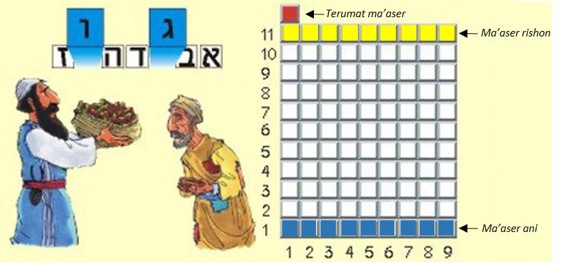
Produce owner giving a poor person ma'aser ani in years 3 & 6
10. Bi’ur ma’aserot (removal of tithes from one’s domain)
After setting aside terumot and ma’aserot one must take the gifts out of one’s home and give them to the individuals for whom the gifts are intended. In addition, terumot and ma’aserot must be separated from any produce in one’s ownership even if it is not meant for immediate consumption.
The obligation of bi’ur ma’aser sheni takes effect on the sixth day of Pesach in both the fourth year of the shemita cycle and in the shemita year. At that time, the sanctity that has been transferred to the designated coins for ma’aser sheni is to be transferred to a coin worth a perutah vareva; this coin is then destroyed. It is also possible to transfer the sanctity of the ma’aser sheni coins to sugar worth a peruta vareva. One can dissolved the sugar in water and pour it in a place where it will not be degraded (it can be poured down a sink drain).

Transferring the sanctity of the coins onto sugar
11. Viduy ma’aserot (tithal declaration)
It is a positive precept to read the verses from Devarim (Duet. 26:12-15) saying that one has fully observed the mitzvah of seperating terumot and ma’aserot. This obligation was in effect after completing bi’ur ma’aserot in the times of the Beit Hamikdash. Today, during the years when there is an obligation to do bi’ur ma’aserot, some recite the verses together in a large gathering of people on the seventh day of Pesach right before minchah to commemorate Temple times.

12. Netinah (giving)
It is a positive mitzvah for the owner of the produce who sets aside terumot and ma’aserot to bring the gifts to their proper destinations: teruma gedola to a Kohen, ma’aser rishon to a Levite, and ma’aser ani to a poor person. Today Kohanim cannot eat terumah since they are ritually impure. However, it is possible to either feed the terumah gedolah to their animals (livestock, pets). Alternatively, one can bury or to double bag the food and dispose of it in the garbage can.
Ma’aser rishon and ma’aser ani separated from tevel vaday, even today, should be given to the people they are meant for; in cases of safek tevel, one needs to set aside but not give these gifts.

Produce owner giving terumot and ma'aserot to Kohen, Levite, and poor person
13. Hafrashah (separation)
A precise designation of the fruits or vegetables meant for each gift. Without this designation, it is forbidden to consume the produce. Hafrashah is a mitzvah in and of itself, even if the gifts are not actually given to the people they are intended for. In the past, when it was possible to give all of the gifts, the act of hafrashah was accomplished by physically setting aside the fruits or vegetables meant for each gift. Today, when it is generally impossible to give all of the gifts (netinah), this designation is performed by making a verbal declaration. One recites the formula of the hafrashah, which defines the quantity of each gift and its location.

14. Hafrashah misafek (separation due to doubt)
The designation of terumot and ma’aserot from produce for which the obligation to do so is uncertain (safek). This produce is forbidden for consumption until terumot and ma’aserot are separated from it. No blessing is recited here, according to the halachic rule “safek berachot lehakel” (we are lenient regarding blessings whose level of obligation is in doubt). Since it is uncertain whether one must perform a hafrashah, the gifts set aside do not definitely belong to a Kohen, Levite, or poor person. For this reason, after making the designation, the owner of the produce does not have to give the gifts, according to the halachic rule “hamotzi mechaveiro alav hare’aya” (whoever takes an object out of another’s possession must first bring proof that it belongs to him). In this case, the produce designated for ma’aser rishon and ma’aser ani are permissible for consumption by their original owner.
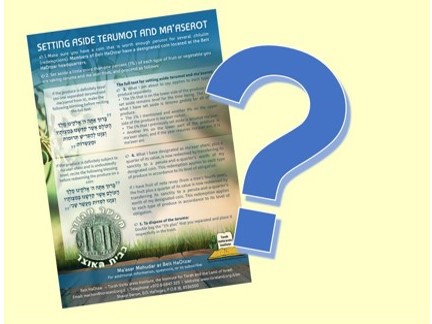
When there is a doubt whether terumot and ma'aserot were separated
15. Onat hama’aserot (tithe season)
The beginning of the ripening of fruits and vegetables. There is no obligation to separate terumot and ma’aserot from fruits or vegetables harvested before this stage.
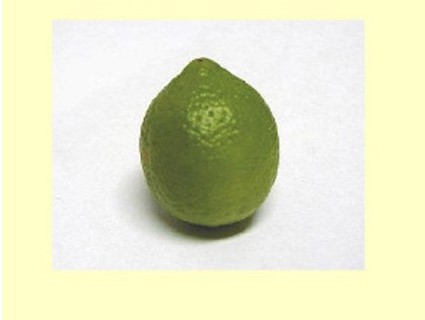
An unripe lemon
16. Shenat ma’aser (tithe year)
A unit of time according to which the laws of terumot and ma’aserot are defined. For example, terumot and ma’aserot are not separated from produce grown in one year on behalf of produce grown in different year.
Also, ma’aser sheni must be taken from produce grown in years 1, 2, 4, and 5 while ma’aser ani is separated from produce grown in years 3 and 6.
For vegetables, the year begins on Rosh Hashanah, and the defining stage is their harvest. That is, a vegetable harvested after Rosh Hashanah belongs to the new year.
For fruit, the year begins on 15 Shevat (Tu BiShevat) and the defining stage for them is chanatah. Fruit that reaches this stage after Tu BiShevat belong to the new year. The definition of chanatah is subject to dispute: the majority opinion is that chanatah is the stage after the blossoms fall off, leaving a small fruit. Others define chanatah as onat hama’aserot, right before the fruit ripens. We generally refer to chanatah as the beginning of fruit formation (or fruit set).
For grains and legumes, the new year begins with Rosh Hashanah. The defining stage is that the kernels have completed one-third of the ripening process (thus reaching onat hama’aserot). Only kernels that are a third-ripened after Rosh Hashanah belong to the new year.
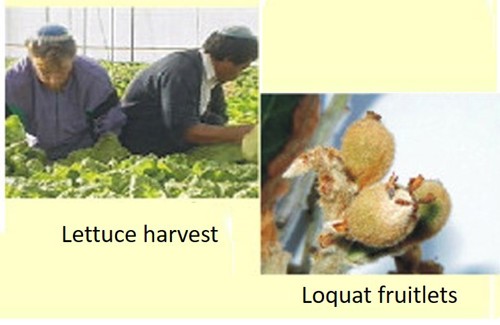
17. Years 1, 2, 4, & 5
The years in the shemitah cycle when ma’aser sheni is separated from fruits and vegetables. The shemitah (Sabbatical) year is the seventh year in the cycle, after which the count starts again.

Ma'aser sheni: Years1, 2,4, & 5
18. Years 3 & 6
The years in the shemitah cycle when ma’aser ani is separated from fruits and vegetables. The shemitah year is the seventh year in the cycle, after which the count starts again.
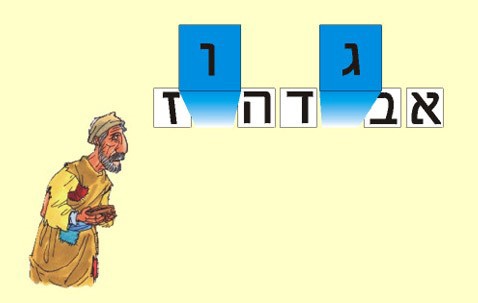
Ma'aser ani: Years 3 & 6
19. Tevel (untithed produce)
Tevel can be read “Tov-lo,” or “not good” in Hebrew. This term applies to produce for which terumot and ma’aserot must be taken but the separation has not yet been made. This produce is forbidden for consumption until process of separating and designating terumot and ma’aserot has been completed.
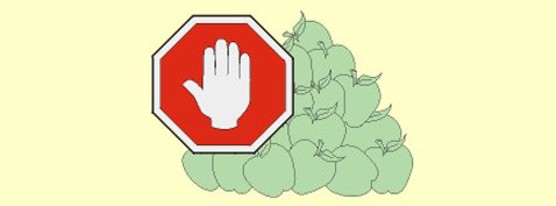
20. Tevel vaday (definitely untithed produce)
Produce for which there is a definite obligation to separate terumot and ma’aserot. The three prerequisites for this status are: (1) The produce was grown in Israel within olei Bavel borders; (2) It is known that terumot and ma’aserot have not been set aside from the produce; (3) The owner of the land is Jewish. A blessing is recited on the separation only on produce defined as tevel vaday. When one is unsure about any of the conditions above, the produce is defined as safek tevel and terumot and ma’aserot are set aside without a blessing.
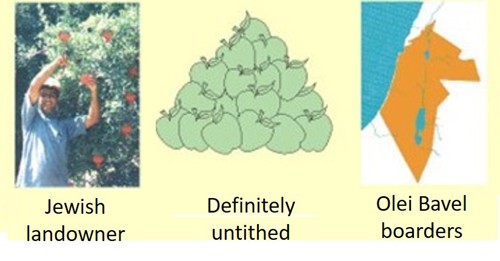
21. Safek tevel (uncertain status of produce)
Produce for which it is uncertain whether there is an obligation to separate terumot and ma’aserot. The three prerequisites for there to be a definite obligation to set aside terumot and ma’aserot are:
(1) The produce was grown in Israel within olei Bavel borders;
(2) It is known that terumot and ma’aserot have not been set aside from the produce;
(3) The owner of the land is Jewish.
When one is unsure about any of the conditions above, the produce is defined as safek tevel yet it is prohibited to consume this produce until terumot and ma’aserot have been taken. Since the status of the produce is in question, no blessing is recited on the separation of terumot and ma’aserot as per the halachic rule “safek berachot lehakel,” we are lenient when it comes to a doubt regarding blessings.
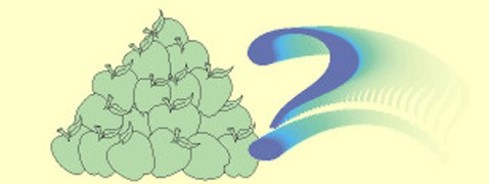
22. Gemar melachah (completion of processing)
An action performed with the produce after its harvest that demonstrates that the harvesting process has been completed. It is forbidden to eat produce meant for sale after gemar melachah before terumot and ma’aserot have been taken. However, it is permissible to eat a little bit (as a snack) from produce for which this action has not yet been performed.
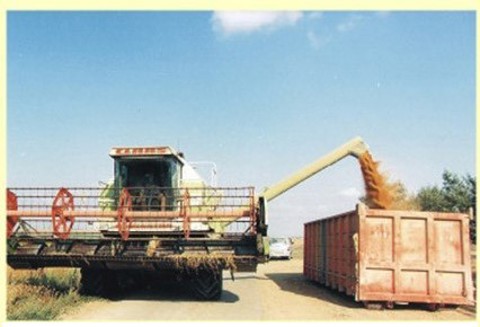
Miru'ach: Unloading wheat into a container after
wheat harvest
23. Borders of olei Bavel
The area that was resettled by Jews who returned to the Land of Israel from Babylon after the First Temple’s destruction. There is an obligation to separate terumot and ma’aserot only from produce that was definitely grown within these borders. That is, it is uncertain that modern-day Israel south of Ashkelon is included in these borders, which is why it is uncertain whether or not there is an obligation to set aside terumot and ma’aserot from the produce grown there. For this reason, terumot and ma’aserot are separated without a blessing as per the halachic rule “safek berachot lehakel.”

24. Kohen (priest)
A person who is known to be a Kohen according to his family tradition. According to halachah, this tradition is sufficient in order to perform the precept of netinah. Today, while Kohanim cannot eat terumah gedolah or terumat ma’aser, it is possible to give Kohanim these gifts for them to feed their pets or livestock.
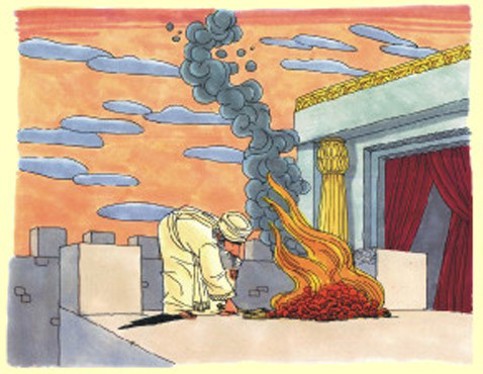
Kohen performing the Temple service
25. Levi (Levite)
Someone who has a family tradition of belonging to the Levite tribe. According to halachah, this tradition is sufficient in order to perform the mitzvah of netinah. One is supposed to give a Levite the ma’aser rishon set aside from tevel vaday.

Levite with a family tradition
26. Levi meyuchas (pedigreed Levite)
A Levite who has a recorded family lineage dating back to the original generations of Levites. It is preferable to give ma’aser rishon taken from tevel vaday to a pedigreed Levite. When there is no Levi meyuchas, one can give the ma’aser rishon to any Levite.

Pedigreed Levites have a recorded family tradition
27. Ani (poor person)
The Mishnah defines a poor person as someone who does not own 200 zuzim. Today a poor person is defined as someone who does not have a steady source of income. One must give ma’aser ani set aside from tevel vaday to a poor person.
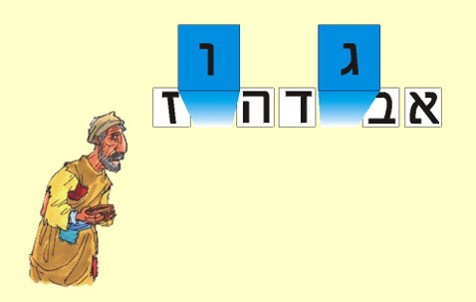
Poor person: Receives ma'aser ani on years 3 & 6
28. Nusach hahafrashah (formula for setting aside)
This formula for separating and designating terumot and ma’aserot was devised by the Sages, and through reading it one performs the mitzvah of hafrashah. Reciting this text precisely designates which produce is to be set aside for each gift, and this constitutes hafrashah. The formula relates to each quantity of produce as a little bit more than one hundred units, based on which it determines the amount to be set aside for each gift and its location. Throwing a little bit of the fruit in the garbage without reciting this text does not count as separating terumot and ma’aserot. After setting aside the terumot and ma’aserot one should complete the process by performing the mitzva of netinah (giving the gifts to the right people). Only after separating the terumot and ma’aserot is it permissible to eat the remaining produce.

29. Blessing for the hafrashah
The blessing one is obligated to recite before fulfilling the mitzvah of separating terumot and ma’aserot. When the status of the produce is uncertain, no blessing is recited upon taking terumot and ma’aserot as per the halachic rule of “safek berachot lehakel,” we are lenient when there is a doubt regarding blessings.

Blessed are You G-d, Our Lord, King of the Universe, Who has sanctified us with His precepts and commanded us to separate offerings and tithes.
30. Me’it (1/100, 1%)
The portion designated for terumat ma’aser. First, a little more than 1/100 (1%) is set aside from the produce. This “little more than” portion is designated as terumah gedolah. The remaining 1% along with another 9 such units (9/100, 9%) of the produce are then designated as ma’aser rishon. In the end, this 1% is also designated as terumat ma’aser, also called ma’aser min hama’aser (tithe of a tithe). In principle, the Levite is supposed to give terumat ma’aser to the Kohen from the ma’aser rishon he receives—10% of the 10% (1% of the original produce).

31. Esser me’iyot (10/100, 10%)
One tenth (10%), the portion designated for the Levite (ma’aser rishon). This tenth is called esser me’iyot, or 10/100, since later on in the hafrashah one tenth is set aside from this unit, which is the 1/100 meant for terumat ma’aser.
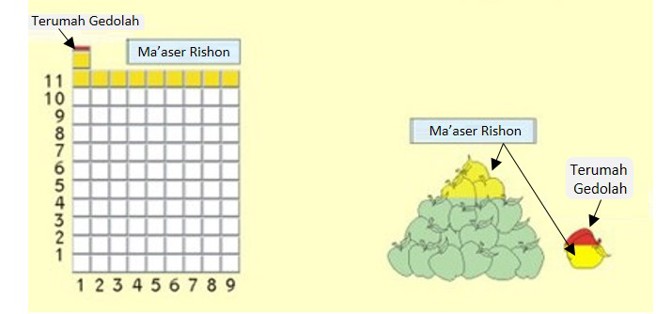
32. Tesha me’iyot (9/100, 9%)
The portion designated for ma’aser sheni or ma’aser ani. This portion is 1/10 of the 90/100 left after the separation of 10/100 for ma’aser rishon.

Nine percent on the bottom: either ma'aser sheni or ani, depending on the year
33. Dargat chiyuv (level of obligation)
The obligation of separating terumot and ma’aserot does not apply to all produce equally. For instance: the obligation to separate terumot and ma’aserot from produce that is tevel vaday is greater than from produce that is safek tevel; the obligation from produce grown within olei Bavel borders is different than from produce grown in olei Mitzrayim borders (the area where the Israelites settled after leaving Egypt; for certain reasons, the level of sanctity in this area is lower than within the olei Bavel borders). When it is known that there are fruits or vegetables with different levels of obligation, one should set aside terumot and ma’aserot from each type separately. That is, more than 1/100 (1%) should be taken from each group with a different level of obligation. One should also ascertain that the coin for chilul ma’aser sheni is worth a sufficient amount of perutot for each level of obligation. Having produce with varying levels of obligation can occur when one purchases the same fruit in an open market from several stands or when purchasing several varieties of the same fruit at one store.

34. Tosefet reva (adding a quarter)
The portion that the owner of the produce must add, as per Torah obligation, to the quantity of ma’aser sheni when transferring its sanctity to a coin in one’s possession. This portion is a quarter (25%) of the value of the ma’aser sheni. The Torah’s term for this portion is chamishit (1/5), since when adding it to ma’aser sheni, there will be five parts all together (chomesh milevar, “a fifth from the outside”). Note that adding a chomesh is only necessary when transferring the sanctity of fruit in one’s possession; if a third party is redeeming the fruit on the owner’s behalf, only the value of the fruit needs to be redeemed.

35. Perutah varevah (a perutah and a quarter)
The amount of money that the sanctity of ma’aser sheni is transferred to. The perutah is 1/40 of the value of a gram of silver. The worth of the perutah fluctuates according to the value of silver. For the current value of a perutah see here. Sages ordained that since now there is no ritual purity or Beit Hamikdash, it is possible to redeem ma’aser sheni produce on a perutah. In practice, today ma’aser sheni is redeemed on a perutah-and-a-quarter in case a quarter is added to the ma’aser sheni needlessly (say, one redeems the ma’aser sheni on a coin belonging to someone else or when the produce belongs to someone else). In such cases, someone redeeming the ma’aser sheni on a perutah has in mind to redeem the ma’aser sheni only on 4/5 of the perutah, which is less than one perutah; some poskim are unsure whether redemption is effective in such cases. For this reason, it is preferable to always use a perutah-and-a-quarter for the redemption. After the redemption, the coin is sacred. It should be kept in a known place, and it is forbidden to use it whatsoever.
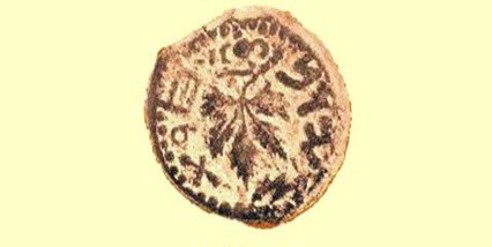
An ancient perutah
36. Matbe’a (coin)
A coin designated for chilul ma’aser sheni and neta revay. It is preferable that this coin be equivalent in value to many perutot. This is because fruits or vegetables of varying levels of obligation require an individual redemption onto a separate perutah; if one were to redeem the different groups of produce at the same time onto one perutah, each group would essentially be redeemed on less than one perutah. After the redemption is performed the coin is imbued with sanctity and it is forbidden to use it whatsoever. When the number of redemptions performed reach the number of perutot in the coin, it is possible to nullify the sanctity of the coin by transferring its sanctity onto sugar worth a peruta-and-a-quarter. The sugar, now imbued with the sanctity of ma’aser sheni, can be dissolved in water and poured down the sink drain or on the ground in a place it will not be degraded.
37. Eating the gifts today
The produce designated for the teruma gedola and terumat ma’aser is forbidden for consumption today, since we are all ritually impure. It should be buried or double wrapped and disposed of in the garbage. The ma’aser rishon and ma’aser ani set aside from tevel vaday are to be given to a Levite and poor person (respectively); these gifts can be consumed like all other food devoid of sanctity. When the status of the produce is in doubt (safek tevel), its status of belonging to the Levite or poor person is also unclear; for this reason, one may keep the produce and even eat it. Today, due to ritual impurity, we cannot consume ma’aser sheni produce, but it is possible to transfer its sanctity to a peruta. After this redemption, the produce set aside for ma’aser sheni is permissible for consumption while the coin is imbued with sanctity.
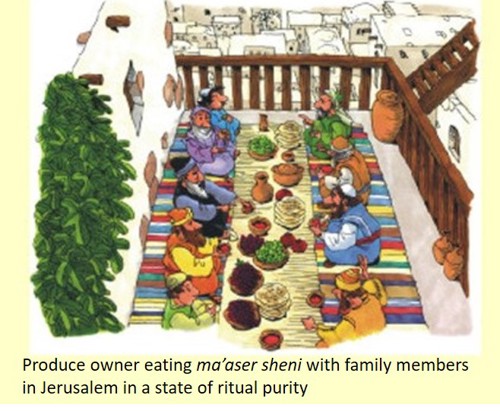
Eating ma’aser sheni in Temple times
38. Beit Ha'otzar
An entity responsible to all of its members to deliver ma’aser rishon and ma’aser ani to their proper destinations and to prepare perutot for each member every day on which members can redeem the sanctity of ma’aser sheni and neta revay from fruits and vegetables. Members of the Beit Ha'otzar fund need to set aside terumot and ma’aserot and recite the formula for the separation (and bury/double bag and dispose of the “1% plus”), but they do not have to physically give the fruit and vegetables designated for ma’aser rishon to a Levite or ma’aser ani to a poor person. This is because, based on halachic sources, the Beit Ha'otzar creates a situation in which these fruits and vegetables are considered payment of a debt by specific Levites or poor individuals against a loan given to them by Beit Ha'otzar members. This allows members of the fund to eat produce designated for ma’aser rishon and ma’aser ani even if set aside from tevel vaday. Moreover, members of the fund need only recite the formula for redeeming ma’aser sheni and neta revay but do not have to designate a special coin for this purpose, since Beit Ha'otzar does this on their behalf.
39. Neta revay (fourth-year fruit)
Fruits of trees that begin to form in a tree’s fourth year of being planted are called neta revay. These fruits are sacred. It is permissible to eat them today only after transferring their sanctity onto a coin (desacrilization or chilul, see below). For this reason, when setting aside terumot and ma’aserot from fruit when there is reason to believe they may be neta revay, one must transfer their sanctity to a coin. In such cases no blessing is recited, as per the rule “safek berachot lehakel.” When one is certain that the fruit has the status of neta revay, it is exempt from the obligation to separate terumot and ma’aserot but chilul must be redeemed with a blessing. For neta revay there are also varying levels of obligation: the sanctity of neta revay for a tree planted with exposed roots is higher than for a tree planted with a clod of earth surrounding its roots. For this reason, each level of obligation must be redeemed separately.
40. Chilul neta revay (desacrilization of fourth-year fruit)
Desacrilization is also refered to as redemption, or pidyon.
The blessing:

Blessed are You G-d, Our Lord, King of the Universe, Who has sanctified us with His precepts and commanded us to redeem fruits of the fourth year.
Formula for chilul neta revay:
The fruits of the fourth year that are here, with an additional quarter of their value, are hereby redeemed by transferring their sanctity to a separate perutah-and-a-quarter’s worth of my designated coin. This redemption applies to each type of produce in accordance with its level of obligation.




